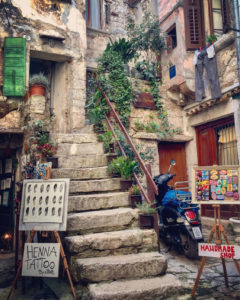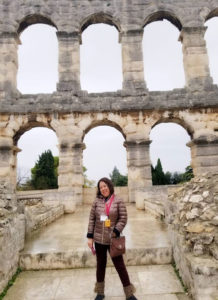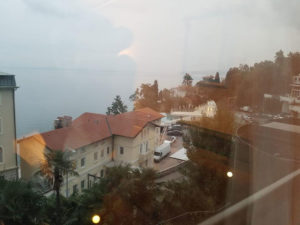
STEPPING outside of our shell to be free from the monotonous grind allows us to enhance our lives, stimulate our dormant mind, and enables us to welcome unfamiliar faces and places. Constant travelers would often say that the world is a book and those who do not travel read only a page… and that being exposed to new cultures and meeting new people will greatly shift one’s paradigm whereby creating a healthier perspective once he returns back home.

Traveling gave me an exciting discovery of many wrong things written and talked about other country’s culture, people, and government. However, I realized the truth after gaining beneficial knowledge about many things that motivated my curiosity even more. After having been disconnected from what I normally do every day and hooked up with quaint and antiquated new worlds, my limited twelve-day Central Europe escapade was more than enough to open my eyes to the grandiose wonders of the less known gems of Croatia, Slovenia, and Montenegro.
Although I wasn’t actually into being a gallivanter or wanderlust since I consider myself as merely a travel enthusiast, my urge to personally see and experience distant places I only saw in movies and magazines strappingly encouraged me to be fearless in the pursuit of what sets my soul on fire… and one gratified attempt led to another.

This time, what actually made me hesitant to pursue my trip to the Balkan countries was the fact that they were once parts of Yugoslavia, a socialist state created after the German occupation in WWII, that was involved in heated ethnic conflicts, wars of independence, and insurgencies from 1001 to 2001. But after being assured that it’s safe, I started to pack my bags and flew to Brussels, Belgium via United Airlines Flight 999 for my connecting flight (Brussels Airlines Flight SN3201) to Venice, Italy where the other members of the group would merge and get picked -up.
It was Thursday, November 22 (Thanksgiving Day) at 6:55 PM when we left Newark International Airport and arrived in Belgium at 8:05 AM (after a 7-hour-10-minute flight) and took Brussels Airlines to Venice, Italy at 9:55 AM for an hour and 25-minute flight. We landed at Marco Polo Venice Airport at 11:30 AM… quite groggy from an exhausting overnight flight.

We’re met by our Tour Director Tena Perkov and driver Damir then headed to Opatija, Croatia… some 232 kilometers (almost 145 miles) away. After passing along winding roads, lofty hills, verdant vegetations, immensely gigantic rocky mountains, and uninhabited places, we finally reached our destination at 4:45 PM: the Grand Hotel Adriatic built atop a hill overlooking the panoramic Adriatic Sea. A group orientation of a modest group of 17 was conducted prior to our first dinner away from home. Since majority of the members were Asian (with just one American from Tucson, Arizona) it was easy for us to bond and instantly develop that in-group feeling.
Incidentally, the Republic of Croatia is a predominantly Christian country at the crossroads of Central and Southeast Europe set along the Adriatic Sea with twenty-one counties, Zagreb being its capital. Croatia provides a social security, universal health care system, and a tuition-free primary and secondary education. On June 25, 1991 Croatia gained independence from Yugoslavia and joined the European Union on July 1, 2013 but since 1994 they used kuna ($1= kn 6,5) for their monetary unit instead of euro.

We were informed that Croatians are huge coffee drinkers and there are more coffee shops than any other business establishments. Natives enjoy sipping coffee in café bars than at home…and are allowed to stay for hours with just a cup of cappuccino or expresso. According to Tena, our Tour Directress, coffee is even considered a great gift idea especially during holidays and special occasions.
Interestingly, sales tax in Croatia is 25%, considered highest in Europe but second only to Hungary. Ironically, while people are hardworking, they opt to keep their money at home rather than in banks and constantly chose to pay in cash.
Croatia’s major industries include shipbuilding (with active shipyards throughout the country), construction, petrochemicals, food processing, farm produce, and currently, tourism. Popular souvenir choices are Sestine umbrellas from Zagreb, traditionally handmade cravats, laces, jackets, cheese, lavender, sea salt, pure virgin olive oil, and honey…and currently the mass production (for worldwide distribution) of their soccer jerseys and related memorabilia after winning 2nd place (France winning as champions) during the recently concluded 2018 FIFA World Cup Championship.

Opatija, Croatia, our two-day residence, is a town in Primorje-Gorski Kotar County in western Croatia which is within the traditional seaside resort on the Kvarner Gulf known for its Mediterranean climate and historic villas and chateaus and century-old buildings… reminiscent of the Austrian Riviera. The city is geographically located on the Istrian Peninsula and a popular summer and winter resort.
According to our guide, the coastal town of Opatija was already a fashionable resort destination of the royalties even during the early 19th century when they started to build elegant Habsburg-era villas and famous Lungomare promenades that snake along the shoreline.
Excited to uncover the “mysteries” behind the exotic villas that lined the main thoroughfare, we dared to walk down the dimly lit narrow side streets before dinner. It was only a little past five but darkness has fallen early in Opatija…with only the enigmatic silhouettes of lofty edifices and ornate villas standing chivalrously like watchtowers prepared to combat and shield their spots against intruders and prowlers. The vicinity was quiet but seemingly safe with full-house bars and cafes operating on both sides.
We stumbled upon their local marketplace (apparently at cessation)…thinking the operations were over due to the absence of animated shoppers and cramming tourists. Our curiosity was caught by attractive items at a souvenir shop. After picking our choices we called the attention of the owner but wasn’t around until a man from two stalls away came to assist us. It wasn’t actually his but he scrupulously attended to us with all sincerity until the real owner came. Verified, Croatians are really known to be innately kindhearted and decorous.
Early morning on our second day, we joined the optional tour to Pula, a provincial center during the later part of the Roman Empire, now home to one of the most impressive constructed Roman architectures outside of Rome, the Arena. We were met by our local tour guide, Andrei, a brawny middle-aged native, who further oriented us about the City of Pula’s colorful past.
Built between 27 BC and 68 AD, the Arena is the only amphitheater in the world with a complete circle wall that could hold 20,000 spectators. It is still being used today as an outdoor cinema and for diverse events such as hockey, concerts, foodie markets, etc.
Ninety percent of Pula’s population are of Roman influence. Pula, being the largest city in Istria County and the 8th largest city in Croatia, is also known for its protected harbor, beach-lined coast, Roman ruins, prehistoric era settlements, and had been occupied, destroyed, and rebuilt numerous times by the Romans, Ostrogoths, Venetians, and allied forces in WWII… and each had administered (with personal agenda) the city.
Pula, being a seafront city on the tip of Croatia’s Istrian Peninsula, is also a major fishing port and if one craves for the freshest oysters and mussels, numerous restaurants along the Limski Canal or nearby eateries have them ready. We had the best opportunity to dine at the world-famous Bistro Alighieri (named after the major Italian poet Dante Alighieri of the late Middle Ages.) It offers an outdoor tent terrace and an indoor cozy ambience diner with retro accents of Sophia Loren’s old movie posters in varied sizes. Since there was a precipitation that day, we chose to have lunch inside… and true enough, they served the freshest wild-caught fish and shelled stuff.

Throughout the summer, Pula is transformed into a city of festivals with every public space hosting international concerts, plays, and film showings. One of Pula’s main attractions is the Lighting Giants installation in Uljanik shipyard where all cranes are lighted and illuminated with various attractive colors.
Since Pula is in the Istrian region, the climate and soil are perfect for producing wine and the region is famous for top quality muscat, merlot, and cavernet sauvignon, all made from the indigenous malvasia grapes. For leisurely shopping and homey café bars, strolling along the main city square and The Forum that features the Temple of Augustus, a well-preserved Roman temple dedicated to the first Roman emperor, Augustus, which, indubitably, was an interesting photography subject.

Later after lunch we drove to Rovinj, Croatia … about 45 minutes away from Pula. A stunning little city in a Croatian fishing port on the west coast of the Istrian Peninsula, Rovinj stands on a headland with colorful-painted houses crowding down the seaport… very Italian in influence! A tangle of winding and narrow cobbled streets leads up to the hilltop Church of St. Euphemia. Rovinj, as quaint as it is fascinating, has only a population close to 15,000 with a market place teeming of locally baked pastries and bread, souvenir items, paintings by local artists, bags and pouches of lavender, and a variety of honey and olive oil. The sleepy city, contrastingly, is kept awake by hordes of tourists and annual visitors.

It was already 5:00 p.m. when we arrived at our hotel after an hour and fifteen minutes of travel (61 miles or 98 km), just perfect to refresh and get dressed-up for our 7:00 dinner.
We retired early to gain renewed energy for the next day’s destination: Split, Croatia.
For comments and suggestions, please email to: [email protected].





